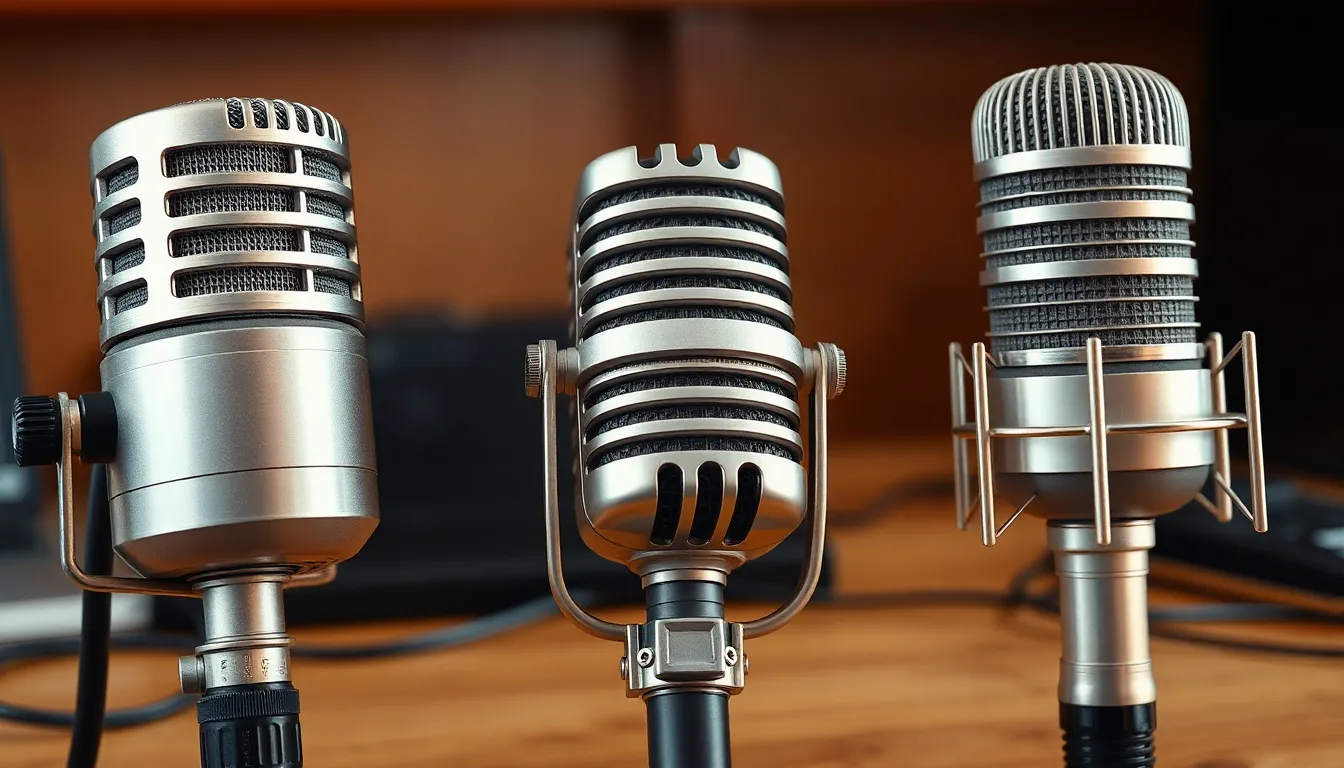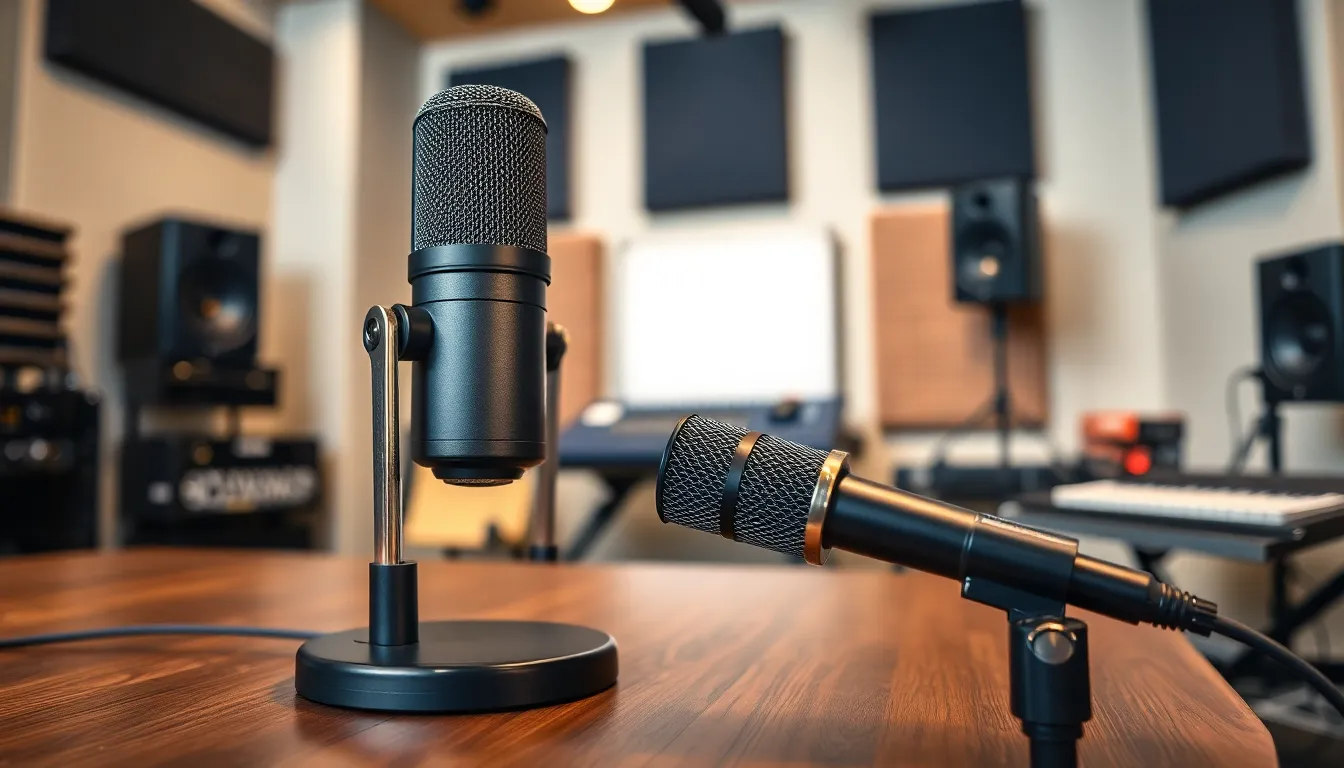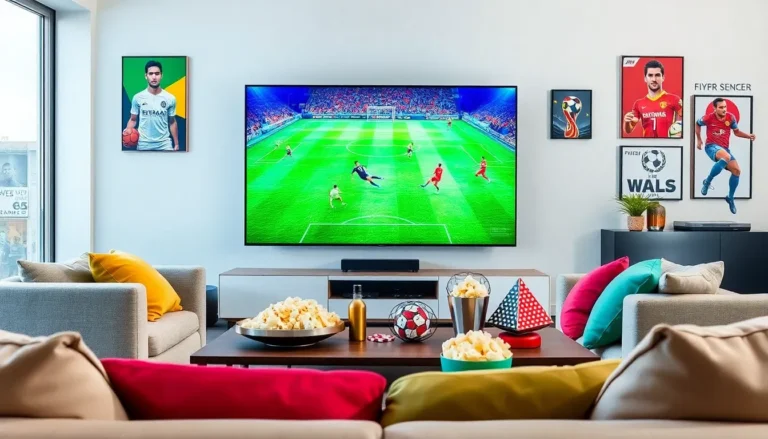In the booming world of podcasting, the right microphone can make all the difference. With countless options available, choosing the perfect one can be overwhelming for both beginners and seasoned podcasters. The quality of sound not only enhances the listening experience but also establishes credibility and professionalism.
From dynamic to condenser microphones, each type offers unique benefits tailored to different recording environments. Understanding these nuances helps podcasters select equipment that suits their style and needs. As the podcasting landscape continues to evolve, investing in a high-quality microphone is essential for anyone looking to captivate their audience and elevate their content.
Table of Contents
ToggleOverview Of Podcasting Microphones
Podcasting microphones come in various types, each tailored for specific recording environments and user needs. The most common types include dynamic microphones and condenser microphones.
Dynamic Microphones
Dynamic microphones are robust and less sensitive to background noise. They excel in loud environments and are suitable for live recordings. Popular examples include the Shure SM7B and the Audio-Technica AT2005USB. These microphones require less power and can handle high sound levels, making them ideal for vocal clarity during podcasts.
Condenser Microphones
Condenser microphones provide superior sound quality, capturing a broader frequency range and finer sound details. They are often preferred in controlled studio settings where sound absorption is optimal. The Rode NT1 and the AKG C214 are notable choices. These microphones require phantom power and can pick up subtle sounds, enhancing the overall audio experience.
USB vs. XLR Microphones
USB microphones connect directly to a computer, simplifying the recording process for beginners. Models like the Blue Yeti offer ease of use and portability. XLR microphones, such as the Shure SM58, provide higher audio fidelity and are suitable for advanced setups. XLR connections typically require an audio interface, allowing for more professional mixing and editing options.
Selecting the Right Microphone
Choosing the right microphone hinges on several factors, including recording environment, budget, and personal preference. Beginners might start with USB microphones due to their ease of use. Experienced podcasters often benefit from the versatility and sound quality of XLR microphones. Consideration of the project’s requirements ensures optimal sound capture, enhancing overall podcast quality.
Types Of Podcasting Microphones

Various podcasting microphones suit different recording scenarios. Understanding these types ensures podcasters select the right equipment for optimal sound capture.
Dynamic Microphones
Dynamic microphones excel in live settings and robust environments. They feature a moving-coil design that captures sound effectively while minimizing background noise interference. This characteristic makes them ideal for recording in untreated spaces or while utilizing loud instruments. Popular models, such as the Shure SM58, are known for their durability and reliability.
Condenser Microphones
Condenser microphones are highly sensitive and capable of capturing a broad frequency range, making them a common choice for studio recordings. They utilize a diaphragm that converts sound waves into electrical signals, producing clear audio with a rich detail. Models like the Audio-Technica AT2020 are favored for voice work due to their ability to capture nuances in tone and clarity.
Ribbon Microphones
Ribbon microphones offer a unique vintage sound characteristic, making them desirable for specific podcasting applications. They possess a thin metal ribbon that vibrates in response to sound waves, resulting in a warm and natural audio output. Though more fragile than dynamic or condenser types, models such as the Royer R-121 offer a compelling option for capturing rich tones, particularly in music or voice work.
Features To Consider
Selecting a microphone involves evaluating several key features to ensure optimal performance for podcasting.
Audio Quality
Audio quality significantly influences the listening experience. Look for microphones that offer high fidelity, with specifications like frequency response and sensitivity. Dynamic microphones excel in handling loud sounds without distortion, while condenser microphones capture a wider frequency range with greater detail. Check for a low self-noise rating to avoid unwanted background sounds. For example, microphones with a signal-to-noise ratio of 70 dB or higher generally provide superior audio clarity.
Connectivity Options
Connectivity plays a crucial role in setup flexibility. USB microphones simplify the connection process, allowing for easy plug-and-play functionality, ideal for beginners. XLR microphones, on the other hand, require additional audio interfaces but offer versatile connection options for professional-grade setups. Review compatibility with mixers, audio interfaces, and recording software to ensure seamless integration.
Portability
Portability is essential for podcasters who record on the go. Lightweight microphones are easy to transport, and models with built-in shock mounts and pop filters enhance usability during travel. Consider compact designs that fit into bags or cases without sacrificing performance. For instance, lavalier and handheld microphones provide convenience for field recordings, making them suitable for diverse podcasting environments.
Top Podcasting Microphones In 2023
Selecting an ideal microphone can elevate the podcasting experience. Here are some top picks for various budgets in 2023.
Recommended Budget Options
- Audio-Technica ATR2100x-USB
Affordable and versatile, this USB/XLR microphone provides excellent audio quality and ease of use.
- Samson Q2U
This USB/XLR microphone is perfect for beginners, featuring a dynamic capsule for reduced background noise and high-quality sound.
- Fifine K669B
A budget-friendly USB mic, it offers impressive sound clarity and is ideal for solo podcasters recording at home.
- Blue Snowball iCE
This iconic USB microphone delivers good audio quality in a compact design and is easy to use for novice podcasters.
Premium Choices
- Shure SM7B
Known for its exceptional sound quality, this dynamic microphone is a favorite among professionals, reducing background noise while capturing rich vocal tones.
- Rode NT1-A
Renowned for its low self-noise levels, this condenser microphone requires careful setup but produces crisp and clear audio perfect for studio recordings.
- Heil PR-40
This dynamic microphone combines high fidelity with a broad frequency response, making it suitable for various recording environments, especially where loud sounds occur.
- Electro-Voice RE20
A staple in broadcast applications, this dynamic microphone is robust and versatile, known for its natural sound reproduction and superior handling of plosives.
These choices cater to varying needs and budgets, ensuring podcasters can achieve high-quality sound that resonates with their audience.
Choosing the right podcasting microphone is essential for creating high-quality audio that captivates listeners. With various options available from budget-friendly to premium models, podcasters can find a microphone that suits their needs and enhances their content. Understanding the differences between dynamic, condenser, and ribbon microphones along with USB and XLR connectivity options allows for informed decisions.
Investing in a quality microphone not only improves sound capture but also elevates the overall podcasting experience. Whether a beginner or a seasoned pro, selecting the right microphone can make all the difference in audience engagement and podcast success. Prioritizing audio quality, portability, and personal preference will lead to a more enjoyable and professional podcasting journey.




